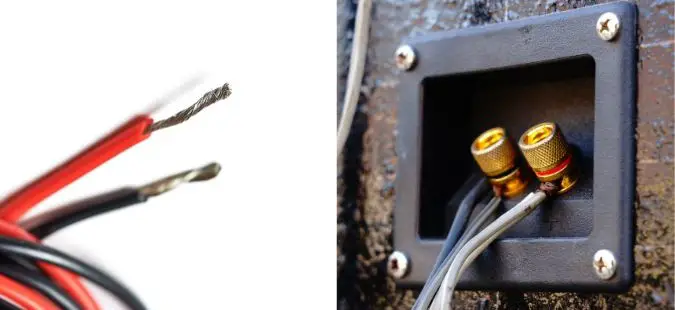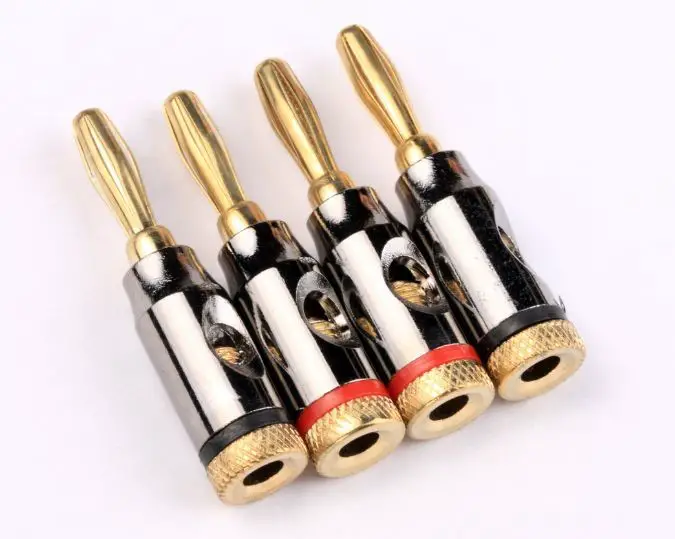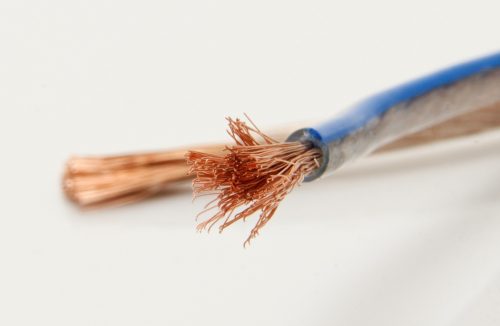One aspect of setting up an audio or home theater system is connecting the speakers, and possibly other components, with speaker wire, and there are a variety of ways to do it with multiple connection type options.
Two common and popular such options are bare wire connections or banana plugs.
Difference Between a Bare Wire vs Banana Plug Connection
A bare wire connection is pretty much what it sounds like: you connect the exposed metallic (usually copper) portion of the speaker wire directly to the connection terminal. This is usually done with spring clips, which can only accept a bare wire connection, but it is also possible to connect bare wire to a binding post.

A banana plug, alternatively, is a simple device that acts as an intermediary – you connect the speaker wire to it, and then you can connect the banana plug to a compatible connection terminal.

Banana plugs are most commonly used with five way binding posts, but it is possible to use them with spring clips with an additional spring clip to banana plug adapter, which is also a simple device.
What is The Purpose of Banana Plugs?
You might be wondering: why pay for and use an additional piece of equipment for connecting speaker wire when it’s not required? What advantages do banana plugs offer that make them worth using?
Benefit #1: Convenience
To connect a bare speaker wire you have to carefully thread the exposed copper portion through an opening that’s usually small, then make sure it sits fully flush on the connection point. This can definitely be a finnicky and annoying process, especially if you have to disconnect and reconnect av components with any degree of frequency.
Contrarily, a banana plug (male connection) easily pops in and out of the banana jack (female connection) just as easily as a regular plug can slide in and out of a wall socket. This makes hooking up, disconnecting, and switching out various audio components much faster and easier to do.
Benefit #2 Consistent and Reliable Connections
Bare wire connections invariably leave some speaker wire exposed to the air, and this can potentially lead to issues over time. Speaker wire can expand and contract with temperature changes, and this can loosen the screw terminals enough for them to need to be periodically tightened.
Exposed bare speaker wire, which is almost always copper, is also prone to oxidation and corrosion, and while this might not affect the connection points directly, it does mean that you’ll probably have to recut and restrip the speaker wire if you ever need to switch the connection.
Banana plugs solve both of these potential problems. Banana plugs and jacks are under spring tension, and both expand and contract with temperature together. Banana plugs are also typically gold plated, the main purpose of which is to make them resistant to oxidation and corrosion.
Benefit #3: Safety
A bare speaker wire consists of a lot of small strands, and these strands have a propensity to fray out and sometimes fall off.
In addition to that being one of the reasons it can be difficult to thread it for bare wire connections, it’s possible for these rogue strands of wire to touch or fall into places where they are not supposed to – like through the vent of a receiver or amplifier for example – and cause potentially disastrous problems. And while the risk of electrical shock from speaker wire is quite low, errant strands that you might accidentally touch or other bare speaker wire that remains exposed do pose some risk there.
A banana plug completely encases this bare portion of the speaker wire and stops these errant wire strands from causing issues.
Does a Bare Wire Connection Give Superior Sound to a Banana Plug Connection?
As great as ease of use is, most people will still prioritize sound quality over convenience and maybe even safety. To that end, there is a claim that bare wire connections give superior sound quality to banana plug connections and are thus “better” connections. One argument for this is that adding any extra parts to a connection chain creates more opportunities for an audio signal to “degrade” and result in worse sound quality coming out of the speakers.
But is this actually true? As it turns out, no. It’s yet another myth in the world of audiophilia. There is no evidence that we’ve seen – or even a plausible physical reason – that a properly connected banana plug couldn’t or wouldn’t transfer an electric audio signal that is exactly the same as it would be if transferred through a direct bare wire connection.
That also conversely means that banana plugs won’t improve sound quality either, an opposite claim which is also sometimes espoused in the audio world.
Are There Any Drawbacks of Banana Plugs Over Bare Wire?
Even though there is no difference sonically between a banana plug or bare wire connection, there are still some possible disadvantages to using banana plugs over bare wire.
Disadvantage #1 – They Take Up More Space
There are times when space for wire connections with audio components is very limited, for example if the terminals on a receiver are very close together or the input panel has to be right up against the wall. It’s possible that banana plugs won’t realistically fit in some situations, whereas a bare wire connection essentially takes up zero extra space.
Disadvantage #2 – More Equipment Costs More Money
You can get decent banana plugs for fairly cheap, but not for nothing, and if you want to use them for every connection point you might need a lot of them and the cost can add up. Add to that the cost of additional adapters and such if you want to make a banana plug compatible with a spring clip, for example.
Conclusion: Are Banana Plugs Worth it?
All things considered, we do think that banana plugs are the best way to connect speaker wire. While they do cost a little extra money and take a little extra time to set up, the benefits they afford – namely that they make connecting and disconnecting audio components much easier – are well worth it.
Frequently Asked Questions About Using Banana Plugs
Do banana plugs fit all speakers and other audio components?
Not directly – banana plugs are compatible with 5-way binding posts. Some speakers and components have spring clip terminals, which banana plugs are not compatible with, but they do make spring clip to banana plug adapters.
Do you need banana plugs for your speaker wire?
No, banana plugs are never required – bare wire connections are also compatible with 5-way binding posts that accept banana plugs. Banana plugs are only ever an optional choice that affords convenience and safety potentially.
Are there different sizes and types of banana plugs?
All banana plugs have the same basic design, but they do come in two sizes: 4mm (standard), and 2mm (miniature). Most audio components, if they come with binding posts, use 4mm compatible banana jacks, but it’s never a bad idea to double check.
Do binding posts accept banana plugs?
Yes, 5-way binding posts are called such because they accept all the standard speaker wire connection types, including banana plugs.
Do banana plugs fit into RCA inputs?
No, banana plugs are not directly compatible with RCA inputs. An RCA plug and a banana plug are distinct and have different shapes. RCA to banana plug adapters do exist though, and there are some cases you might use this type of connection, but it is not common.
Do you need to solder banana plugs?
No, you simply need to thread the speaker wire through, splay it out, then screw the banana plug so that it sits tight and flush with the speaker wire. Adding a banana plug to a bare speaker wire terminal doesn’t require any tools and can easily be done in less than a minute.

